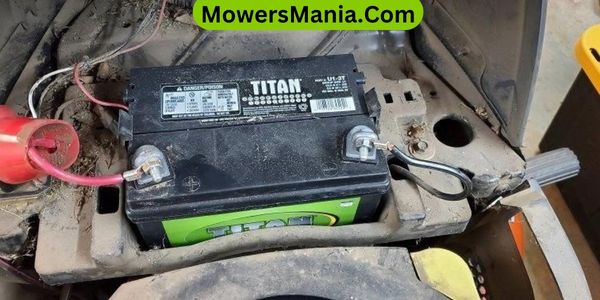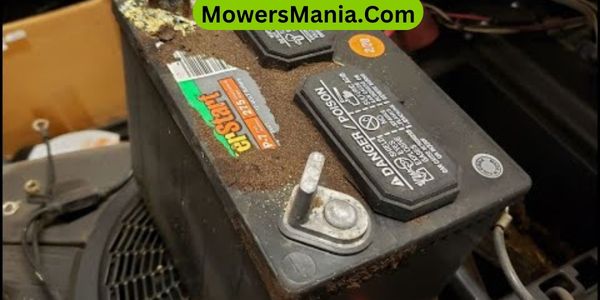When it comes to your lawn mower, the battery is like the heart of the machine, providing the power it needs to keep going.
But if you’ve been facing the frustration of a constantly dying or draining battery, there could be a few reasons behind it.
From neglecting maintenance to dealing with a faulty charging system, there are several factors that can contribute to this issue.

Understanding these reasons can help you troubleshoot and prevent further problems, ensuring that your lawn mower stays up and running when you need it the most.
Neglecting Maintenance
If you neglect regular maintenance, your lawn mower battery will keep dying and draining prematurely. Regular maintenance is crucial for the longevity and efficiency of your lawn mower battery.
One common mistake is forgetting to clean the battery terminals. Over time, corrosion can build up on the terminals, leading to poor electrical conductivity and ultimately causing the battery to die prematurely.
Additionally, failing to check the electrolyte levels can also contribute to the battery’s premature demise. Low electrolyte levels can lead to decreased battery performance and a shorter lifespan.
Another aspect of maintenance often overlooked is keeping the battery securely fastened. Vibrations from the lawn mower can cause the battery connections to become loose, leading to electrical issues and draining the battery.
Lastly, ignoring the overall condition of the lawn mower can impact the battery. A worn-out or faulty charging system can overwork the battery, causing it to drain quickly.
Faulty Charging System
When a lawn mower’s charging system is faulty, it can lead to repeated battery issues and premature drainage, impacting the overall performance of your equipment. The charging system comprises the alternator, voltage regulator, and battery.
If the alternator fails to generate sufficient power to recharge the battery, or if the voltage regulator malfunctions and overcharges the battery, it can result in a drained battery.
This can happen even while the mower is running, as the faulty charging system fails to maintain the battery’s charge. Additionally, loose or corroded connections in the charging system can disrupt the flow of power, further contributing to battery drainage.
To address a faulty charging system, start by inspecting the alternator, voltage regulator, and battery connections for any signs of damage, wear, or corrosion.
Check the alternator’s output using a multimeter to ensure it’s generating the correct level of voltage. If the alternator, voltage regulator, or connections are found to be faulty, they should be repaired or replaced promptly to prevent further battery issues.
Regular maintenance and testing of the charging system can help identify and rectify problems before they lead to battery drainage.
Corrosion and Dirt Buildup

You can prevent corrosion and dirt buildup by regularly cleaning and applying a protective coating to the battery terminals and connections.
Corrosion and dirt can accumulate on the battery terminals and connections over time, leading to poor electrical conductivity and draining the battery. To combat this, it’s essential to inspect and clean the battery regularly.
Here’s a simple guide to help you maintain your lawn mower battery:
| Steps to Prevent Corrosion and Dirt Buildup |
|---|
| 1. Turn off the lawn mower: Ensure the mower is turned off before inspecting or working on the battery. |
| 2. Inspect the battery: Check for any signs of corrosion or dirt on the terminals and connections. |
| 3. Clean the terminals: Use a mixture of baking soda and water to clean the terminals and a wire brush to remove any corrosion. |
| 4. Apply a protective coating: After cleaning, apply a thin layer of petroleum jelly or a battery terminal protectant to the terminals to prevent future corrosion. |
Regular maintenance and proper cleaning will not only prevent corrosion and dirt buildup but also extend the life of your lawn mower battery.
Parasitic Drain
To prevent parasitic drain, regularly inspect and replace any worn or damaged wiring connected to the battery. Faulty or frayed wiring can lead to an electrical leak, causing the battery to drain even when the lawn mower isn’t in use.
Check the wiring harness for any signs of wear, especially in areas where it may come into contact with sharp edges or moving parts.
Additionally, ensure that all connections are secure and free from corrosion. Any loose or corroded connections can create resistance and result in a parasitic drain on the battery.
It’s also important to assess any aftermarket accessories or modifications that have been added to the lawn mower. These additions can sometimes draw power from the battery, even when the mower is turned off. Consider installing a disconnect switch for these accessories to completely cut off power when they aren’t in use.
Finally, be vigilant about turning off the ignition switch when the mower isn’t in operation. Leaving the ignition switch on, even without the engine running, can lead to a parasitic drain on the battery over time.
Extreme Temperature Fluctuations

One solution for combating extreme temperature fluctuations that can affect your lawn mower battery is investing in a battery tender or maintainer.
These devices are designed to monitor the charge of your battery and provide a trickle charge when needed, helping to extend its lifespan especially in fluctuating temperatures.
Additionally, taking some simple precautions such as storing your lawn mower in a sheltered area, away from direct sunlight or extreme cold, can also help mitigate the impact of temperature changes on the battery.
To further understand how extreme temperature fluctuations affect your lawn mower battery, consider the following table:
| Temperature | Battery Impact |
|---|---|
| High | Accelerates electrolyte evaporation, leading to decreased battery life |
| Low | Reduces the ability of the battery to provide sufficient power for starting |
Frequently Asked Questions [FAQs]
Can Using a Larger Lawn Mower Battery Prevent It From Draining Quickly?
Using a larger lawn mower battery can prevent it from draining quickly. The increased capacity allows for longer use between charges. It’s important to ensure the battery is compatible with your mower and properly maintained.
How Often Should I Clean the Battery Terminals to Prevent Corrosion Buildup?
You should clean the battery terminals every few months to prevent corrosion buildup. Use a mixture of baking soda and water to scrub the terminals with a brush, then rinse with clean water and dry thoroughly.
Are There Any Signs That Indicate a Parasitic Drain Is Affecting My Lawn Mower Battery?
If your lawn mower battery is draining, be on the lookout for signs of parasitic drain, like dim lights when the engine is off or difficulty starting. These could indicate an issue with the electrical system.
Does Extreme Heat or Cold Have a Bigger Impact on Draining the Battery?
Extreme heat has a bigger impact on draining the battery. In hot weather, the battery’s capacity reduces, leading to faster drain. Keep the mower in a shaded area and consider a battery with higher heat resistance to combat this issue.
Can I Use a Trickle Charger to Prevent My Lawn Mower Battery From Dying?
Yes, you can use a trickle charger to prevent your lawn mower battery from dying. It’s a good way to maintain the battery’s charge and prolong its lifespan. Just make sure to follow the manufacturer’s guidelines.
Conclusion
So, if your lawn mower battery keeps dying and draining, there are a few common reasons to consider.
By addressing these potential issues, you can help prevent your lawn mower battery from constantly dying and draining.



